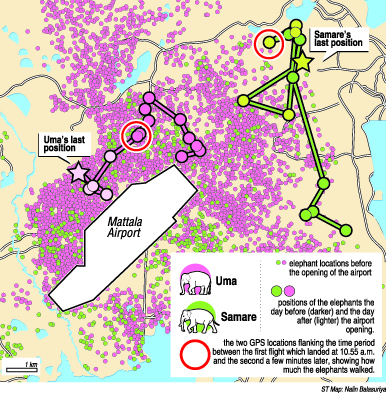News
Jumbos not bothered about Mattala
View(s):By Kumudini Hettiarachchi
The elephants are a-roaming, going about their routine of foraging and resting, with nary a worry about the mechanical winged giants of the air landing and taking off from Mattala.
Concerns that the flights coming into the newly-opened Mattala Rajapaksa International Airport at Hambantota would disrupt the lives of the elephants in the area have been effectively laid to rest, the Sunday Times understands.
This conclusion has been arrived at not just through observation, but by scientifically tracking them, pointed out Dr. Prithiviraj Fernando, Chairman of the Centre for Conservation and Research (CCR), who has been instrumental in placing radio collars on two elephants in the area in collaboration with the Department of Wildlife Conservation (DWC).
The two elephants with radio collars moving around the Mattala airport are ‘Uma’, a female, and ‘Samare’, a young adult male. Uma’s herd consists of about 35 elephants, both females and their young ones, which are all related to her. Her roaming patterns represent the movements of the entire herd, the Sunday Times learns. Samare, meanwhile, is on the verge of leaving the herd in which he was born, which has about 25 elephants. Like human youth who wish to find their feet, he sometimes joins other herds but at other times ranges alone.
Every four hours, the exact location of the elephant is recorded by a GPS instrument in the collar and transmitted once a day to the researchers via satellite, it is understood. CCR researchers used this information to check whether the elephants showed any response to the flights that came in on the day of the opening.
Comparing the dots on the map to the elephants, Dr. Fernando says that the movement data of Samare are represented by the blue dots and the ranging pattern of Uma’s herd by the green dots. The small dots are the elephant locations before the opening of the airport and the large dots the positions of the elephants the day before (darker) and the day after (lighter) the airport opening. The last position is marked with a star. The first flight landed at 10.55 a.m. and the second a few minutes later. The two GPS locations flanking that time period are encircled in red, showing how much the elephants walked just after the first two flights arrived.
Uma’s herd was about 2km north of the airport the night before and was moving in a south-west direction parallel to the airport on the opening day. They continued to move in that direction and after spending some time almost at the airport fence, they moved in a north-west direction. Samare who was about 8km from the airport on the day it opened, moved in a southerly direction coming towards the airport and then moving away, Dr. Fernando said. “Therefore, neither Uma nor Samare showed that they were disturbed by the incoming flights but indicated a very normal pattern of ranging.”
Calling this airport “unique” because it is the only one in the world where “one could practically watch elephants from the airport,” he said it is thus well positioned to develop wildlife tourism for the benefit of the country. It strongly brings into focus the fact that planned development and conservation can go hand-in-hand.
It helps when the environment is taken into consideration before a project is launched, Dr. Fernando reiterated, pointing out that the Mattala Managed Elephant Range within which the airport lies was very much a part of the Environmental Impact Assessment under which approval for the airport project was given by the Central Environmental Authority. This has ensured that the airport would have no negative impact on the elephants.
While this is very positive, it should be ensured that it remains so even during further expansion, this elephant expert cautioned, adding that “we need to take into account the requirements of other species also in our development process. If we do that we can gain both from the development process and conservation”.
Follow @timesonlinelk
comments powered by Disqus


















